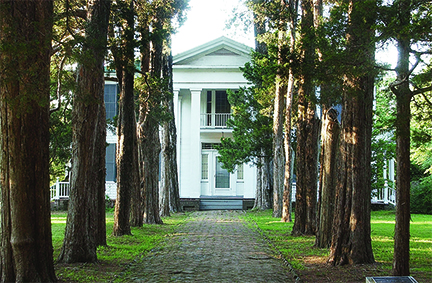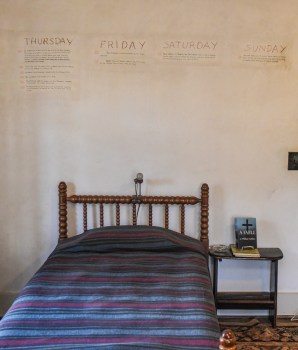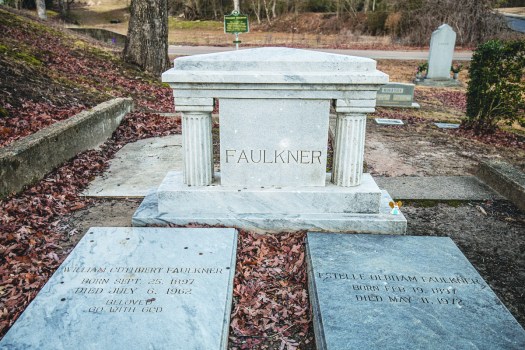Keeping Rowan Oak
Published 6:53 pm Friday, March 15, 2024
By Clifton Odom
Photos by Bruce Newman
When my publisher mentioned that we would be interviewing Bill Griffin at Rowan Oak for our 2024 issue of “Profile,” I eagerly raised my hand, hoping I might get the nod.
In all my years at Ole Miss and working in Oxford, I’ve never actually taken the time to go to Rowan Oak during business hours and get the “full experience.” As I walked beneath the steady cedars I was struck, as always, by the hushed beauty of that space.
It was quiet on a Wednesday afternoon, except for an occasional tourist snapping a selfie or glancing at a map.
I was invited through the creaking screen door by Rowan Oak curator Bill Griffin, who was holding a cordless phone and patiently explaining event rental details.
The minute I entered, I felt like I was in someone’s comfortable home. The house features an eclectic mix of Victorian, Greek Revival and Colonial Revival styles, as well as photography and memorabilia reflecting the various periods of its existence.
I’m directed to a well-worn chair in the foyer and wait patiently. After his call, I start with my questions and immediately realize with pleasure that this interview will be anything but formal!
Bill joined Ole Miss in 1992 as the University Museum Collections manager after extensive training in preservation and archaeology. Shortly after he started at the university, Rowan Oak’s management shifted from the University of Mississippi English Department to University Museums and Historic Homes. It was at this time that the curator also departed.
After a two-year search, Bill became interim – then full-time curator – in 1999. During his 25 years, he has overseen several extensive renovations. ”Part of keeping a historic structure in good working order is constant maintenance,” Bill explained.
It’s at this point in our conversation that a female visitor from Baltimore walked in the front door clutching an Oxford map and wearing athletic shorts, fanny pack, visor and sunglasses. I got to see Bill in his element welcoming one of his guests as I realized that one of our area’s best and most knowledgeable guides is right here at Rowan Oak.
Bill, along with his assistant curator Rachel, welcomes somewhere between 10,000 to 12,000 visitors per year. Numbers have suffered due to COVID-19, but are on the rise.
When Bill arrived at Rowan Oak in the early 1990s, the property was still basically “a private home” and a shrine to the literary legacy of William Faukner. Bill saw the potential for much more.
It was during his tenure that Rowan Oak evolved into a working museum, where people could not only visit the grounds and the historic home, but also learn about the life of Mr. Faulkner to get an idea of what Oxford and the South was like during that time.
Tucked away in the back gallery is a very impressive exhibit of images and memorabilia from the renowned Cofield Collection. The images give visitors a glimpse of Faulkner, the man – who he was and how and where he lived.
When I asked Bill where he got this amazing collection, he proudly said that he had rescued it from storage in the basement of City Hall. The exhibit had been featured in the previous “Visit Oxford” location, but, due to lack of space, it had been stored away.
Rowan Oak, located in Oxford, is a historic home on Old Taylor Road with a rich history married to the region’s cultural heritage. Built in 1844, Rowan Oak has become an iconic landmark and symbol of the Southern literary tradition.
Rowan Oak was originally named “The Bailey Place” by its first owner, Robert Sheegog, who constructed the two-story Greek Revival style home. In 1859, the property was sold to Col. Robert Sheegog’s daughter, Lucy Thompson, and her husband, Dr. Thomas Bailey Aldrich. They subsequently renamed the estate “Rowan Oak” after the rowan tree, an ancient Celtic symbol of protection and inspiration.
Of course, the most famous resident of Rowan Oak was the renowned American author William Faulkner. Many visitors assume Mr. Faulkner lived here for generations, but he had purchased the property in 1930, making it his home until his death in 1962.
During his 30-plus years at Rowan Oak, Faulkner penned some of his most celebrated works, including “As I Lay Dying,” “Light in August” and “Absalom, Absalom!” The house served as a source of inspiration for Faulkner’s fictional setting of Yoknapatawpha County, which appears in many of his novels and short stories.
Visitors can even see his handwritten notes for the novel “Sanctuary” scribbled on the walls in an upstairs bedroom. Rowan Oak is not only significant for its association with Faulkner, but also for its architectural and historical value.
In 1972, Rowan Oak was designated a National Historic Landmark, a token of its literary and architectural significance at a national level. That same year, the house and surrounding grounds were sold to Ole Miss and are now open to the public as a museum and meeting and event space.
Tuesday through Sunday visitors to Rowan Oak can explore the rooms where Mr. Faulkner lived and worked, view his personal belongings and gain insight into his creative process.
My last question for Bill was whether or not he could confirm one of the more colorful “tall tales” I’ve heard about Mr. Faulkner. He smiled wryly and responded with the perfect Faulkner quote: “Never let the truth get in the way of a good story…”
Rowan Oak stands as a testament to the enduring legacy of William Faulkner and his timeless influence on the Southern literary tradition. It serves as a cultural mecca for literature enthusiasts and a place of high inspiration for locals and aspiring writers, preserving and celebrating the rich history of Oxford, Mississippi.















